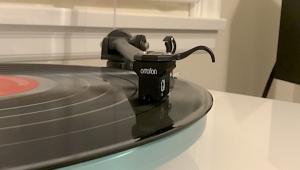Any recommendation for a good, low-cost, digital 'scope to comfortably handle the audio range and raw output from low-output moving coils up through OTL tubed output stages to drive electrostatics?
Soundsmith Strain Gauge SG-200 phono cartridge system

As if he's not got enough to do building his extensive lines of moving-iron cartridges, preamplifiers, amplifiers, and speakers, Soundsmith's Peter Ledermann also makes a full line of strain-gauge cartridge systems available with a choice of six user-replaceable stylus profiles. I believe the Soundsmith is the only strain-gauge cartridge currently made anywhere in the world. Ledermann says it takes him a full day to build one.
I've often seen—and sometimes even heard—Soundsmith's blue-lit strain-gauge models at Consumer Electronics Shows and various consumer audio events, but only in entirely unfamiliar systems. Because of the impossibility of making any kind of judgment of their sound under such conditions, I've pretty much ignored what I heard in those rooms, though the reactions of other listeners have ranged wildly, from wide-mouthed "Wow!"s to scrunched-face grimaces of distaste. All it did was intensify my curiosity to hear one at home in my own system.
However, because a strain-gauge model requires an active power source, the cartridge must be used with an outboard preamplifier and power supply. Until very recently, Soundsmith incorporated its strain-gauge circuitry within a wide range of standalone full-function preamplifiers: if you wanted to own or review one of their Strain Gauge models, you had to replace your preamplifier with Soundsmith's—not only an unattractive proposition for anyone already happy with his or her preamp, but the simultaneous swapping out of two audio components makes for an unsatisfactory review context: how do you know which new component is doing what to the sound?
Soundsmith now offers its Strain Gauge cartridge with a reasonably priced dedicated interface that simply and only plugs into any preamplifier's line-level input. Ledermann says that this circuit is identical to what's in the full-featured preamps. The long-promised SG-200 system, which Soundsmith calls its "entry-level" model, recently arrived here, and I immediately installed it in a Graham Engineering Phantom II tonearm.
What is a strain-gauge cartridge, anyway?
In a standard phono cartridge, a mass—a magnet or a coil—must be moved to generate a voltage. The mass must be supported by an elastomer suspension that acts as a kind of shock absorber for the mass, which is attached to a cantilever-stylus assembly. When that assembly moves, displaced by the modulations in the record groove, it in turn moves the coil or magnet. A certain amount of that transferred energy is transformed into heat in the suspension and is thus lost. The coil-magnet system turns what's left into a tiny amount of voltage.
A strain gauge is a tiny piece of silicon or other material whose resistance to a current flow supplied to it changes as it expands and contracts. It's typically used in devices that measure pressure. A stereo strain-gauge phono cartridge uses two of these ultradelicate devices, which are flexed by the cantilever pressing on the carrier holding them. The design of the Strain Gauge carrier is proprietary to Soundsmith, and Ledermann didn't want to tell me much about it. The interface that supplies current to the cartridge includes a low-noise preamplifier that increases the cartridge's tiny modulated voltage to line level.
The biggest advantage of such a system over a standard voltage-generating system such as a moving-magnet or a moving-coil is, of course, that virtually no mass need be moved in order to produce a modulated voltage, which means that almost no energy is lost in overcoming the inertia of a magnet or coil. The stylus-cantilever system can therefore respond far more quickly, and so is able to more accurately trace the groove walls. Theoretically.
Displacement-, not velocity-based performance
I haven't mentioned RIAA equalization so far because, with this system, none is needed.
RIAA equalization is applied when a lacquer is cut, attenuating the low frequencies and boosting the high frequencies. When the resulting LP is played, a complementary RIAA filter in the preamplifier attenuates the highs, dropping noise in this region well below audibility while restoring flat HF response. Attenuating the lows during cutting limits the lateral groove displacement, thus permitting a tighter groove spiral, which means that more music can be packed onto each LP side. When the record is played, the preamp's RIAA equalizer restores a flat bass response to the sound by boosting the lows.
- Log in or register to post comments




















































